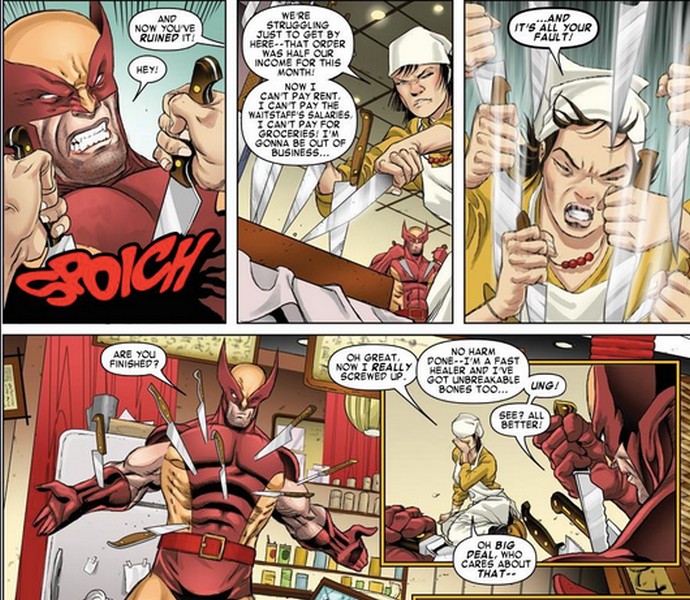Wolverine Does Age, but It’s Complicated & Here’s Why

Out of all the characters in the comics with a healing factor, Wolverine is by far the most popular. This is in part because his healing factor is simply overpowered by what he is capable of doing. He can regenerate entire limbs and organs. He can withstand unimaginable levels of toxins, viruses, and other calamities. But is his healing factor able to stop aging completely? Well, this is what we set out to explore today as we explain the background of Wolverine’s decelerated aging.
Wolverine is over a hundred years old, but he aged normally only after he hit young adulthood
We know that Wolverine is over a century old, being born around 1882 and 1885. His healing factor first manifested when he was 13 years old. We know that James aged normally up to that point since his family and he would notice if it was slower. He was a pretty regular child when it came to physical aspects, and as with most mutants, his powers manifested in his teen years.
As far as the lore goes, Wolverine aged normally until he reached adulthood. Like normal humans, Wolverine grew and developed until he hit that magical 25th year. At that point, his aging rapidly decreased, and he has remained almost unchanged for almost a hundred years. Why? Because he is still human when we come to the bottom of it. But this explanation might be confusing, so let’s explore the details.
Wolverine’s healing factor is proportionate to the damage he receives
Even though aging is a normal part of human life, something that is programmed into our every cell, it’s still damage at the end of the day. Programmed biological damage.
Wolverine has no control over the healing factor, and it passively works in the background at all times, only revealing itself when Wolverine is damaged. The bigger the extent of his damage, the more his healing factor needs to kick in to repair it.
The thing about aging is that until you hit 25, more cells are created and rejuvenated daily than destroyed. Until you reach 25 years old, your cells are growing, and you are developing, that is, unless you have some disorder that inhibits that process. So he aged normally until he hit 25 because his healing factor didn’t really have anything to inhibit. Normal cell growth is not something that Wolverine’s healing factor messes with. If it was, Wolverine would be covered in tumors and wouldn’t be able to function.

After 25 years, this process reverses, and more cells are getting destroyed than they are created. This is the so-called degenerative stage of human life; we can slow down the process to an extent, but we can’t really truly stop it. Wolverine’s healing factor inhibits this process and is more or less capable of regenerating damage that comes with aging, functionally stopping Wolverine’s aging altogether, at least in theory.
In theory, Wolverine’s healing factor should pick up the slack and repair all the damage that aging has done to his body. But in the comics and in the movies, we’ve seen something reverse happening.
Wolverine’s healing rate is affected by many factors, as well as his aging
Wolverine’s abilities have been nerfed several times, as well as increased several times over the long history of the character. We know that it is possible to kill him, although the process is gruesome and devastating for everyone involved, but it’s possible.
We also know that Wolverine can regenerate pretty much any part of his body except for his Adamantium skeleton, and even though Adamantium makes him considerably stronger and gives him the ability to go unharmed after devastating blows that would have otherwise shattered every bone in his body, it also affects his healing factor negatively.
Adamantium poisons Wolverine’s body, and since it’s pretty much a magical metal, it’s nearly impossible to predict every effect that it will have on human (or mutant) physiology, and it’s impossible to slow down this poisoning. We’re not dealing here with food poisoning or something man-made. It’s one of the strongest metals in the Marvel Universe with mystical origins.
The longer Wolverine has Adamantium within him, the slower his healing factor becomes, and it’s getting harder to repair the damage; thus, his aging also accelerates. This is something we’ve seen in the movie ‘Logan.’
Wolverine died in the movie because he was older, under the effects of adamantium poisoning, and at one point, it became impossible for him to repair the damage. When he died, he was 191 years old, which is much older than the oldest recorded human, and if he hadn’t died in combat, it’s possible that he would have continued living for several more decades before the effects of Adamantium were able to catch up and completely stop his healing factor in tracks.
Something similar was seen in the comics as well: Adamantium negatively affected Wolverine’s healing factor. When Adamantium was pulled from his body, his healing factor recovered and increased at a rapid pace.

But he slowed down again when he met Lazaer, the Angel of Death.
Following his recent death and the loss of his healing factor, Wolverine has been resurrected by using the Mutatn Resurrection Protocol at Krakoa. And there hasn’t been any reference to his healing factor yet and how fast it is, but we can assume that it’s closer to pre-adamantium values.
To summarize everything, Wolverine does age far slower than regular humans. The faster his healing factor is, the slower he will age. If his factor is slowed down, like, for example, with Adamantium poisoning, Wolverine aging accelerates.
Have something to add? Let us know in the comments below!

